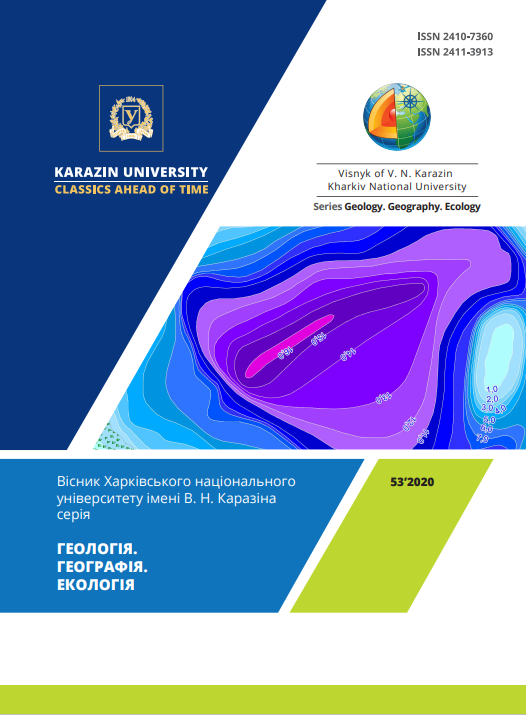Застосування енергобалансової моделі приземного шару для розрахунку випаровування з водних об'єктів
Анотація
При вирішенні гідрологічних завдань, пов'язаних з водним балансом водойм і можливістю господарського використання їх водних ресурсів, важливою проблемою є точне визначення випаровування з водної поверхні, яке є основною складовою втрат води. Особливо гостро стоїть питання визначення випаровування з водної поверхні невеликих водойм, які знаходяться в умовах посушливого клімату і для яких випаровування може бути значним.
При цьому найбільш надійним способом розрахунку випаровування з поверхні води є використання параметричних атмосферних LS-моделей, які дозволяють врахувати всі особливості волого-теплообміну між земною поверхнею і атмосферою. Однією з таких моделей є енергобалансова модель SLEB (Surface Layer Energy Balance), яка розроблена в Одеському державному екологічному університеті, вихідними даними якої є стандартна метеорологічна інформація. Перевагою даної моделі є висока точність визначення втрат тепла на випаровування при достовірних оцінках маса-теплообміну між підстильною поверхнею і атмосферою. Метою даного дослідження є розрахунки кількісних змін випаровування з водних поверхонь за допомогою моделі SLEB та їх порівняння з виміряними і модельними даними, отриманих аналогічними методами інших авторів (Іванова, Пенмана) на прикладі прісноводного озера Ялпуг. Результати показали, що розрахункові величини випаровування з водної поверхні за методами Пенмана і Іванова завищують кількість вологи, що випарувалася в порівнянні з вимірюваними та розрахованими за моделлю SLEB величинами.
Таким чином, застосування моделі SLEB дозволяє покращити точність кількісної оцінки втрат води на випаровування з водної поверхні водойм, що в свою чергу, може підвищити ефективність управління водними ресурсами природних водойм з метою їх раціонального використання для питного водопостачання та зрошення земель.
Завантаження
Посилання
Budyko M.I. (1956). Heat surface balance, 256.
Mezentsev V.S. (1962).To the method of calculating the the total evaporation and soil moisture characteristics for an intra-annual period. Proceedings of the Omsk Agricultural Institute, XXVII, 35-54.
Ivanov N.N. (1954). Obout of the determination of the evaporation values. Proceedings of the Russian Geographical Society, 86 (2).
Beven Keith. (1979). A sensitivity analysis of the Penman-Monteith actual evapotranspiration estimates. Journal of Hydrology, 44 (3-4), 169-190. https://doi.org/10.1016/0022-1694(79)90130-6.
Monteith J.L., Penman H.L. (1965). Evaporation and environment. Symposia of the Society for Experimental Biology, 19, 205-224.
Budagovskij А.I. (1969). Evaporation of soil moisture. Moscow: Nauka, 241.
Konstantinov А.R. (1968). Evaporation in nature. Leningrad: Gidrometeoizdat, 582.
Pushistov P.Yu., Shlychkov V.A. (1992). Conclusion of balance relations for the mesoscale climate model of heat and moisture exchange in the atmosphere - hydrosphere - vegetation - soil system. Proceedings of SibNIGMI, 100, 129-146.
Postnikov А.N. (2009). Methods for calculating soil evaporation in various natural zones. Scientific notes of the Russian State Hydrometeorological University, 10, 21-31.
Priestly C.H.B. and Taylor R.J. (1972). On the Assessment of Surface Heat Flux and Evaporation Using Large-scale Parameters. Monthly Weather Bev, 1, 81-92. https://doi.org/10.1175/1520-0493(1972)100<0081:OTAOSH>2.3.CO;2.
Brutsaert W. (1982). Evaporation in to the Atmosphere (Theory, History and Applications). D. Reidel Publishing Co., Dordrech, Boston, London, 299.
XU C.-Y and V.P. SINGH. (2002). Cross Comparison of Empirical Equations for Calculating Potential Evapotranspiration with Data from Switzerland. Water Resources Management, 16, 197-219.
Jensen M.E. and Haise H.R. (1963). Estimation of Evapotranspiration from Solar Radiation. Journal of Irrigation and Drainage Division, Proc. Amer. Soc. Civil Eng, 89, 1541.
Hargreaves G.H. and Samni Z.A. (1982). Estimation of Potential Evapotranspiration. Journal of Irrigation and Drainage Division, Proceedings of the American Society of Civil Engineers, 108, 223-230.
Berry J.A., Baker I., T. Randall, D.A. Sellers. (2012). Soils, plant growth and crop production. P. J. The Soil-Plant-Atmosphere System. Past and Present – Vol. 1. (Soil-Plant-Atmosphere Dynamics).
Chen F., Pielke R., Sr. K. Mitchell. (2001). Development and application of land-surface models for mesoscale atmospheric models. American Geophysical Union, 107-135.
Xiu A., Pleim J.E. (2001). Development of a land surface model. Part I: Application in a mesoscale meteorological model. J. Appl. Meteorol, 40 (2), 192-209. https://doi.org/10.1175/1520-0450(2001)040<0192:DOALSM>2.0.CO;2.
Voloshin V.G. (2013). Dynamic model of atmospheric pollution with a meteorological preprocessor. Оdessа: TES, 285.
Stepanenko S.N., Voloshin V.G., Kuryshina V.Yu. (2011). The surface layer energy balance model. Ukrainian hydrometeorological journal, 9, 38-59.
Rauner Yu.L. (1972). Heat balance of vegetation. Leningrad: Gidrometeoizdat, 210.
Voloshin V.G. (2002). Method for calculating turbulent flows and surface temperature based on meteorological observations. Meteorology, climatology and hydrology, 46, 83-89.
Voloshin V.G., Kuryshina V.Yu. (2016). Dissipation functions of turbulent energy in the atmospheric surface layer. Ukrainian hydrometeorological journal, 15, 2-8. https://doi.org/10.31481/uhmj.16.2015.09.
Stepanenko S.N., Voloshin V.G., Kuryshina V.Yu., Golovatyuk N.D. (2012). Method for calculating the surface temperature by standard meteorological observations. Ukrainian hydrometeorological journal, 11, 18-29.
Gippius F.N., Arkhipkin V.S., Frolov A.V. (2016). Seasonal course evaporation from Caspian surface taking into account the influence of waves and sea depth. Moscow University Bulletin. Series 5. geography, 5, 86-91.





